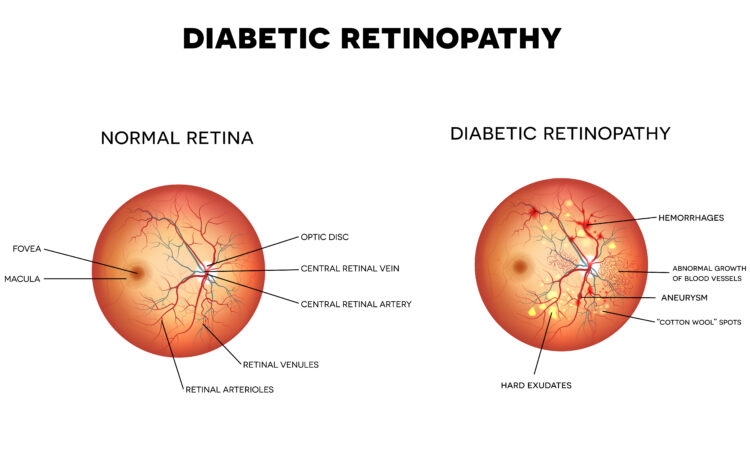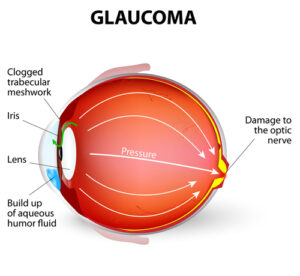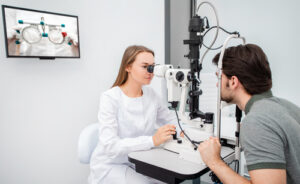If you have diabetes, the condition can affect your health in several ways. One of the most important things to be aware of regarding diabetes is how it affects how healthy your eyes are.
There are several eye conditions associated with diabetes. Many of these, like diabetes, have no cure but are manageable. Still, many people with diabetes can completely lose their vision to diabetic eye disease.
Regular eye exams are vital to preserving your vision to detect and treat these eye conditions as early as possible. Keep reading to find out what you need to know about diabetic eye care and how you can keep your eyes healthy!
Diabetes and Eye Health

Diabetes, especially type 2 diabetes, which patients tend to develop later in life, puts you at risk for a few eye conditions. This is because diabetes causes high blood sugar.
High blood sugar can affect the blood vessels in your eye. More specifically, they affect the blood vessels in your retina, which is why retinal diseases are often linked to diabetes.
Diabetes can also put you at higher risk for eye conditions that don’t affect the retina. However, retinal disease is one of the primary concerns regarding diabetic eye conditions.
Your retina is a vital part of your eye. The thin membrane lines the back of your eye and contains photoreceptor cells.
These cells absorb the light that passes through your eye and send impulses through the optic nerve to your brain, turning the information into images. High blood sugar levels can cause the vessels that provide blood to the retina to swell and even leak, damaging the retina.
Photoreceptor cells are destroyed when damaged, limiting the information the retina can receive and send. Destroying photoreceptor cells causes vision loss.
Any vision loss because of retinal damage is irreversible and cannot be fixed. But you can slow down the damage to prevent further vision loss. This is why it’s so important to have regular eye exams to ensure the early diagnosis of any diabetic eye conditions.
Diabetic Eye Conditions
Several eye conditions are associated with diabetes. They include:
Diabetic Retinopathy

Diabetic retinopathy directly results from high blood sugar due to diabetes. It occurs when blood vessels under the retina grow abnormally, causing swelling and leaking.
Leaking blood vessels cause scar tissue to form on the retina, damaging it. Early symptoms include blurry vision and gaps in your eyesight.
The symptoms of diabetic retinopathy become irreversible once they are noticeable and affect your vision. But you can detect the condition during an eye exam before symptoms occur, making it crucial to undergo eye exams regularly.
Macular Edema
Macular edema occurs when the macula, the retina’s center, swells. Experiencing macula edema is often a complication of diabetic retinopathy and causes similar symptoms, particularly in the center of your vision.
Vitreous Hemorrhage
A vitreous hemorrhage is also usually a complication of diabetic retinopathy. It occurs when blood leaking from the retina gets into the vitreous, the gel that fills your eye. It often causes spots and floaters to appear in your vision.
Glaucoma

Glaucoma is not a retinal eye condition, and it isn’t a direct result of diabetes. However, many doctors estimate that having diabetes doubles your risk for glaucoma.
Glaucoma is caused by high eye pressure, which strains the optic nerve, damaging it. Damage to the optic nerve causes tunnel vision.
Like with retinal conditions, visual symptoms of glaucoma are irreversible once they occur. However, an eye exam can detect visual symptoms of glaucoma, even if you haven’t started showing any visible signs of the eye condition.
Assessing Your Risk
One of the best ways of preemptively dealing with diabetic eye conditions is to be aware of your risk. Your risk for diabetic eye conditions isn’t just determined by whether or not you have diabetes.
When assessing your risk, there are several other things your eye doctor looks out for, including:
- How long you’ve had diabetes
- How well do you manage your diabetes
- Your age (you’re at the highest risk when you’re over 60)
- Your ethnicity (those of African and Hispanic descent are at higher risk)
When you and your doctor determine your risk, you can choose how often to schedule eye exams. Remember, vision loss from most of these conditions is irreversible.
Eye exams are the only way to diagnose these eye conditions before you experience any symptoms. It’s best to know your risk and see your eye doctor accordingly to keep your eyes happy and healthy!
Preventative Care
There are some ways your can lower your risk for diabetic eye conditions. The best way to reduce your risk is to keep your diabetes well-managed.
The higher your blood sugar is, the more likely you are to develop diabetic eye conditions. But you can’t entirely eliminate your risk for diabetic eye conditions as many risk factors are out of your control.
You can reduce your risk of vision loss by seeing your eye doctor for regular eye exams!
Treatment

There is no cure for most diabetic eye conditions but there are treatments. These treatments can slow the damage and preserve your vision for years to come.
These treatments are most effective if you receive an early diagnosis. See your eye doctor regularly to ensure you can schedule eye exams.
Patients with diabetes should have their eyes examined every year. If you’re at higher risk, you may require exams even more frequently.
Ready to make your eyes a priority? Request an appointment at Loden Vision Centers in Nashville, TN, now! Having diabetes means your eyes require a little extra tender loving care in the form of eye exams.


